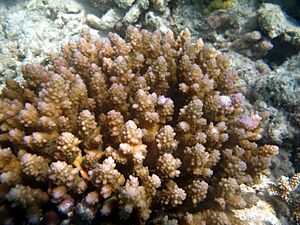Acropora polystoma facts for kids
Quick facts for kids Acropora polystoma |
|
|---|---|
 |
|
| Conservation status | |
| Scientific classification | |
| Synonyms | |
|
The Acropora polystoma is a type of coral that lives in the ocean. It belongs to a family of corals called acroporid corals. A scientist named G. Brook first described this coral in 1891.
You can find Acropora polystoma in warm, tropical ocean waters. It lives on the upper parts of coral reefs where the waves are strong. This coral usually grows at depths between 3 and 10 meters (about 10 to 33 feet) underwater.
Scientists have listed Acropora polystoma as a vulnerable species on the IUCN Red List. This means its population is decreasing, and it could be at risk of disappearing if we don't protect it. It is not a very common coral, but it can be found across a large area. It is also protected under CITES Appendix II, which helps control its trade.
Contents
What is Acropora polystoma?
Acropora polystoma corals live together in groups called colonies. These colonies can look like clumps or flat, plate-like shapes. They can grow up to 80 centimeters (about 31 inches) wide.
The coral has small branches, called branchlets. These branchlets can be up to 100 millimeters (about 4 inches) long. They are usually between 5 and 15 millimeters (about 0.2 to 0.6 inches) thick.
This coral comes in many beautiful colors. It can be blue, cream, yellow, lavender, or brown. Its branches are similar in size but get thinner towards their ends.
Coral Parts: Corallites
The branches of Acropora polystoma have special structures called corallites. These are like tiny cups where the coral polyps (the living animals) live.
- Axial corallites: These are found at the very tips of the branches. They are small, with an outer width of 2.4 to 4 millimeters. Their inner opening is about 0.8 to 1.5 millimeters wide.
- Radial corallites: These corallites are arranged in neat rows along the sides of the branches. They are shaped like small tubes.
The coral also has a few tiny, sharp bumps called spinules. Acropora polystoma looks a lot like Acropora massawensis and other corals in a group called the robusta group. This coral is made of a hard material called aragonite, which is a form of calcium carbonate.
Where does Acropora polystoma live?
Even though Acropora polystoma is not very common, it is found across a wide part of the world. Its home includes:
- The Gulf of Aden
- The Indian Ocean
- The Indo-Pacific region
- Southeast Asia
- Australia
- The western Pacific Ocean
You can also find this coral in countries like Japan, American Samoa, and the Cook Islands. It lives in five different regions of Indonesia too. In French Polynesia, these corals release their eggs and sperm to reproduce in October.
Threats to Acropora polystoma
Sadly, the population of Acropora polystoma is shrinking. Many things threaten this coral, including:
- Reef destruction: Damage to the coral reefs where it lives.
- Climate change: Changes in the Earth's climate.
- Rising sea temperatures: Warmer ocean water can cause coral bleaching, where corals lose their color and can die.
- Coral disease: Illnesses that affect corals.
- Predators: Starfish like the Acanthaster planci (Crown-of-thorns starfish) eat corals.
- Human activity: Things people do, like pollution or building near reefs.
Because it is vulnerable, Acropora polystoma is listed on the IUCN Red List and CITES Appendix II. It might also be found in special areas called Marine Protected Areas, which are places set aside to help protect ocean life.
How was Acropora polystoma discovered?
The first time this coral was officially described was in 1891. It was named Madrepora polystoma by G. Brook. Later, its name was changed to Acropora polystoma.


